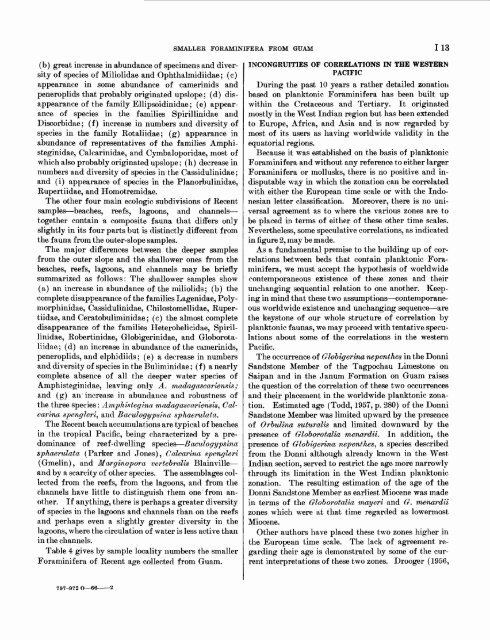Smaller Foraminifera From Guam - USGS
Smaller Foraminifera From Guam - USGS
Smaller Foraminifera From Guam - USGS
Create successful ePaper yourself
Turn your PDF publications into a flip-book with our unique Google optimized e-Paper software.
(b) great increase in abundance of specimens and diver<br />
sity of species of Miliolidae and Ophthalmidiidae; (c)<br />
appearance in some abundance of camerinids and<br />
peneroplids that probably originated upslope; (d) dis<br />
appearance of the family Ellipsoidinidae; (e) appear<br />
ance of species in the families Spirillinidae and<br />
Discorbidae; (f) increase in numbers and diversity of<br />
species in the family Rotaliidae; (g) appearance in<br />
abundance of representatives of the families Amphi-<br />
steginidae, Calcarinidae, and Cymbaloporidae, most of<br />
which also probably originated upslope; (h) decrease in<br />
numbers and diversity of species in the Cassidulinidae;<br />
and (i) appearance of species in the Planorbulinidae,<br />
Rupertiidae, and Homotremidae.<br />
The other four main ecologic subdivisions of Recent<br />
samples beaches, reefs, lagoons, and channels<br />
together contain a composite fauna that differs only<br />
slightly in its four parts but is distinctly different from<br />
the fauna from the outer-slope samples.<br />
The major differences between the deeper samples<br />
from the outer slope and the shallower ones from the<br />
beaches, reefs, lagoons, and channels may be briefly<br />
summarized as follows: The shallower samples show<br />
(a) an increase in abundance of the miliolids; (b) the<br />
complete disappearance of the families Lagenidae, Poly-<br />
morphinidae, Cassidulinidae, Chilostomellidae, Ruper<br />
tiidae, and Ceratobuliminidae; (c) the almost complete<br />
disappearance of the families Heterohelicidae, Spiril<br />
linidae, Robertinidae, Globigerinidae, and Globorota-<br />
liidae; (d) an increase in abundance of the camerinids,<br />
peneroplids, and elphidiids; (e) a decrease in numbers<br />
and diversity of species in the Buliminidae; (f) a nearly<br />
complete absence of all the deeper water species of<br />
Amphisteginidae, leaving only A. madagascariensis ;<br />
and (g) an increase in abundance and robustness of<br />
the three species: Amphixtegina. madagascariensis^ Cal-<br />
carina spengleri, and Baculogypsina sphaerulata.<br />
The Recent beach accumulations are typical of beaches<br />
in the tropical Pacific, being characterized by a pre<br />
dominance of reef-dwelling species Baculogypsina<br />
sphaerulata (Parker and Jones), C alcanna spengleri<br />
(Gmelin), and Marginopora vertebralis Blainville<br />
and by a scarcity of other species. The assemblages col<br />
lected from the reefs, from the lagoons, and from the<br />
channels have little to distinguish them one from an<br />
other. If anything, there is perhaps a greater diversity<br />
of species in the lagoons and channels than on the reefs<br />
and perhaps even a slightly greater diversity in the<br />
lagoons, where the circulation of water is less active than<br />
in the channels.<br />
Table 4 gives by sample locality numbers the smaller<br />
<strong>Foraminifera</strong> of Recent age collected from <strong>Guam</strong>.<br />
797-972 O 66<br />
SMALLER FORAMINIFERA FROM GUAM 113<br />
INCONGRUITIES OF CORRELATIONS IN THE WESTERN<br />
PACIFIC<br />
During the past 10 years a rather detailed zonation<br />
based on planktonic <strong>Foraminifera</strong> has been built up<br />
within the Cretaceous and Tertiary. It originated<br />
mostly in the West Indian region but has been extended<br />
to Europe, Africa, and Asia and is now regarded by<br />
most of its users as having worldwide validity in the<br />
equatorial regions.<br />
Because it was established on the basis of planktonic<br />
<strong>Foraminifera</strong> and without any reference to either larger<br />
<strong>Foraminifera</strong> or mollusks, there is no positive and in<br />
disputable way in which the zonation can be correlated<br />
with either the European time scale or with the Indo<br />
nesian letter classification. Moreover, there is no uni<br />
versal agreement as to where the various zones are to<br />
be placed in terms of either of these other time scales.<br />
Nevertheless, some speculative correlations, as indicated<br />
in figure 2, may be made.<br />
As a fundamental premise to the building up of cor<br />
relations between beds that contain planktonic Fora<br />
minifera, we must accept the hypothesis of worldwide<br />
contemporaneous existence of these zones and their<br />
unchanging sequential relation to one another. Keep<br />
ing in mind that these two assumptions contemporane<br />
ous worldwide existence and unchanging sequence are<br />
the keystone of our whole structure of correlation by<br />
planktonic faunas, we may proceed with tentative specu<br />
lations about some of the correlations in the western<br />
Pacific.<br />
The occurrence of Globigerina nepenthes in the Donni<br />
Sandstone Member of the Tagpochau Limestone on<br />
Saipan and in the Janum Formation on <strong>Guam</strong> raises<br />
the question of the correlation of these two occurrences<br />
and their placement in the worldwide planktonic zona<br />
tion. Estimated age (Todd, 1957, p. 280) of the Donni<br />
Sandstone Member was limited upward by the presence<br />
of Orbulina suturalis and limited downward by the<br />
presence of Globorotalia menardii. In addition, the<br />
presence of Globigerma nepenthes, a species described<br />
from the Donni although already known in the West<br />
Indian section, served to restrict the age more narrowly<br />
through its limitation in the West Indian planktonic<br />
zonation. The resulting estimation of the age of the<br />
Donni Sandstone Member as earliest Miocene was made<br />
in terms of the Globorotalia, mayeri and G. menardii<br />
zones which were at that time regarded as lowermost<br />
Miocene.<br />
Other authors have placed these two zones higher in<br />
the European time scale. The lack of agreement re<br />
garding their age is demonstrated by some of the cur<br />
rent interpretations of these two zones. Drooger (1956,

















